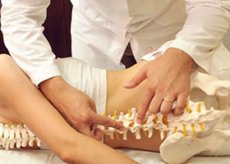Medical expert of the article
New publications
Osteochondrosis of the spine: symptoms, diagnosis, treatment
Last reviewed: 05.07.2025

All iLive content is medically reviewed or fact checked to ensure as much factual accuracy as possible.
We have strict sourcing guidelines and only link to reputable media sites, academic research institutions and, whenever possible, medically peer reviewed studies. Note that the numbers in parentheses ([1], [2], etc.) are clickable links to these studies.
If you feel that any of our content is inaccurate, out-of-date, or otherwise questionable, please select it and press Ctrl + Enter.

Osteochondrosis of the spine is a fairly common disease. Contrary to popular belief, it occurs not only in older people, but also in 20-year-olds, and its onset is quite unexpected: you can feel a sharp attack of pain when bending over to pick up a fallen item, leaning over a table, or simply making some movement. Over the years, the likelihood of getting sick increases - among people aged 40-50, there are practically no people who have never experienced pain in the neck and back.
In fact, osteochondrosis of the spine is changes occurring in the spinal column itself and in the tissues located near it, as a result of which both internal organs and nerves and muscles suffer. Needless to say, the consequences of these transformations can be quite disastrous? Therefore, if you have the slightest doubt whether you have osteochondrosis of the spine, consult a doctor!
What causes osteochondrosis of the spine?
As mentioned earlier, anyone can develop osteochondrosis of the spine, regardless of age, gender and occupation. However, those who suffer most from it are either those who engage in heavy physical labor every day, constantly straining the spine, or, on the contrary, those who constantly work at the computer, without devoting time to exercise, physical education and walking. Both the first and second cases lead to wear and tear, muscle fatigue, improper blood circulation, which leads to problems in the spine. Osteochondrosis of the spine is characterized by the appearance of back pain, which can be caused by the following factors:
- Injuries received;
- Diseases of internal organs;
- Infections;
- Flat feet;
- Stress.
Whatever the cause, osteochondrosis of the spine has a certain range of symptoms.
What are the symptoms of spinal osteochondrosis?
The problem with self-diagnosis of osteochondrosis is the breadth of its symptoms: patients may have pain in completely different parts of the body that are not related to the spine. Thus, patients most often experience the following:
- Recurrent back pain;
- Numbness in arms and legs;
- Discomfort in the neck, shoulder joints;
- Painful sensations in the chest;
- Unpleasant sensations in the heart area;
- General fatigue and malaise;
- Headache, malaise.
What stages does osteochondrosis of the spine go through?
There are four stages of the disease:
- Washing out of moisture from the nucleus pulposus, which changes its position. At this stage, blood circulation is also disrupted.
- Stretching of muscles as a result of a reduction in the distance between the places where they are attached.
- Inflammation of the discs without damage to the fibrous ring (protrusion).
- Adaptation of the spine to a new condition - the growth of adjacent vertebrae.
How to identify osteochondrosis of the spine?
In order to diagnose osteochondrosis of the spine, the doctor, first of all, talks to the patient, studying information about his lifestyle, habits, paying special attention to complaints, since some of them are characteristic "alarm bells". Various tests (for example, blood and urine) may also be required.
Among the modern methods of diagnosing the disease, the following can be distinguished:
- X-ray;
- Computed tomography;
- Myelography;
- Magnetic resonance imaging.
For greater certainty in the diagnosis of spinal osteochondrosis, the patient can undergo examination by a neurologist, cardiologist, traumatologist, gastroenterologist, etc. After determining the nature of the disease, its treatment begins, which depends on the stage.
Who to contact?
How is osteochondrosis of the spine treated?
Osteochondrosis of the spine is most often treated with the following means: chondroprotectors, anti-inflammatory drugs, muscle relaxants, tranquilizers. However, for complete relief from pain, drugs alone are not enough. Often, doctors also prescribe a course that includes some procedures from the following list:
- Therapeutic massage;
- Manual therapy;
- Electrophoresis;
- Acupuncture;
- Laser therapy;
- Vacuum therapy;
- Hydromassage.
For greater effect, conservative treatment is supplemented with therapeutic exercise and a trip to a sanatorium.
More information of the treatment
How to prevent osteochondrosis of the spine?
- To prevent osteochondrosis, you need to follow a few simple tips:
- Lead an active lifestyle;
- Do not eat a lot of fatty, salty, spicy foods;
- Exercise in the pool, gym;
- Use orthopedic mattresses.
Osteochondrosis of the spine accompanies many of us, however, this does not mean that you should allow it to ruin your life! Therefore, at the first symptoms of the disease, you should start its prompt treatment!


 [
[